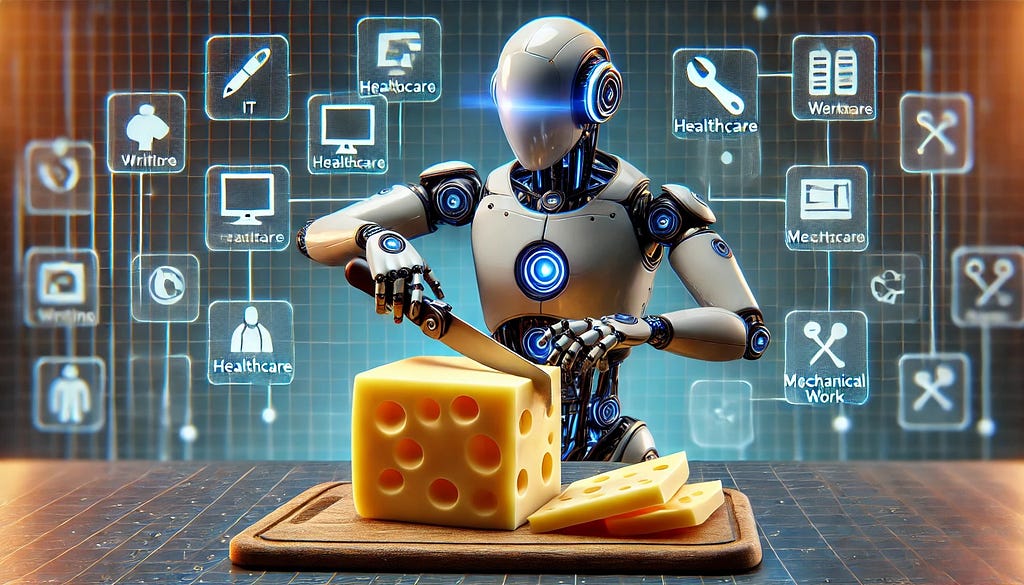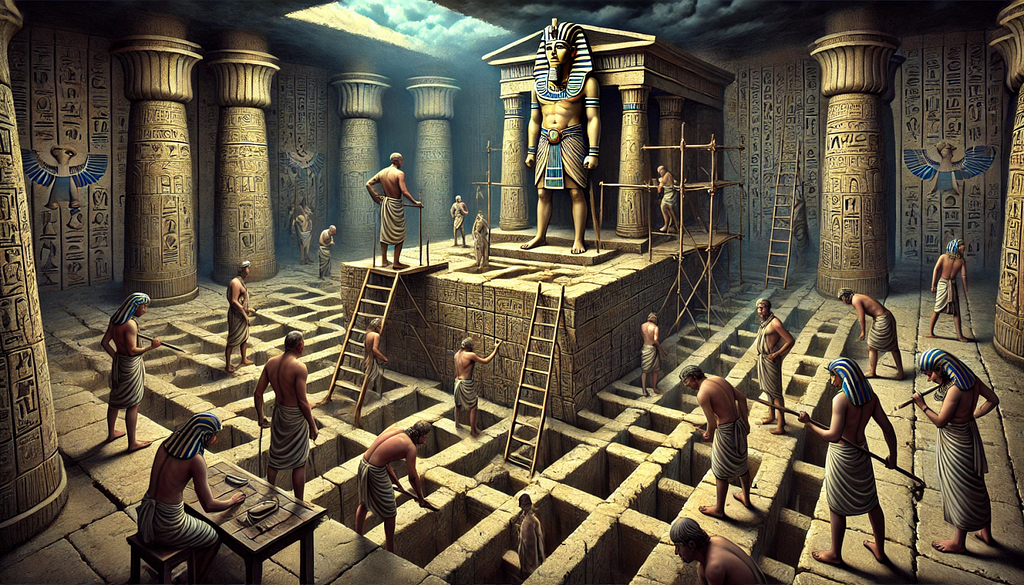I hope I am wrong…
In the late 19th and early 20th centuries, Frederick Taylor introduced a management approach that would fundamentally change the industrial world. With tools as basic as a pen, ledger, and stopwatch, Taylor meticulously observed and recorded the activities of factory workers, aiming to enhance efficiency through what he termed “scientific management.” This system dissected every action into its basic elements. Taylor’s analysis led to the precise timing and reorganization of each task to maximize speed and efficiency. Initially, these changes led to significant productivity gains, but they also stripped workers of their autonomy and sense of craftsmanship. Understandably, Taylorism reduced skilled artisans to interchangeable cogs in a mechanized process.
Fast forward to today, and Taylor’s shadow looms large over modern workforce management. Today’s management practices have evolved to slice jobs into ever-smaller tasks. In 2019, The Wall Street Journal highlighted a significant shift towards workplace surveillance, labelling employees as “workforce data generators.” This marked a new phase in management’s scientific approach, now armed with AI-driven tools far beyond Taylor’s stopwatch.
The COVID-19 pandemic and the shift to remote work turbocharged the use of these surveillance tools. A 2021 study by Gartner revealed that the adoption of technologies like facial recognition among employers had doubled to 60% during the pandemic, with predictions of continued growth. This surge in monitoring tools reflects a crisis-induced rush towards greater control, reminiscent of Taylor’s response to perceived inefficiencies.

“Optimism, like pessimism, is a bias, and to be avoided. But summoning the determination to rise to a challenge and succeed is a virtue.” — Calum Chace
The narrative has been that a surefire way to protect yourself in an age of AI is to have a complex, human job. However, when you really examine any complex job it is just a Gordian knot of simple tasks, tasks that can be cheese sliced apart. Consider, AI-powered project management software that eliminates middle management by automating tasks. Once it has unbundled jobs into tasks, it then assembles freelance teams. While these freelancers initially benefit, the software soon learns from their work, and gradually replaces them too.
Freelancers are increasingly becoming a significant part of the workforce. A 2022 study by Upwork found that 38% of Americans engaged in freelance work. However, much of this work often involves performing highly specific, repetitive tasks — essentially slicing off a narrow piece of a broader job. These tasks are precisely the kind most vulnerable to automation, leaving freelancers not only contributing to efficiency but also unknowingly putting their own livelihoods at risk as machines learn to replace their roles entirely.
This trend isn’t isolated. AI is transforming fields from journalism to radiology, steadily reducing human roles. Taylor’s stopwatch has become the algorithm, and while efficiency soars, the impact on workers echoes the mechanised dehumanisation of Taylorism. This wave will impact computer and software programmers, data analysts, a host of media and marketing jobs, teachers, paralegals, financial advisors, consultants, and functional specialists in large organizations.

“One of the inevitable results of downsizing is plummeting employee morale. Employees have a hard time squaring all the talk about the importance of human capital with seemingly indiscriminate cutting. They are too often confronted with a lose-lose proposition: “If you don’t become more efficient, you’ll lose your job. By the way, if you do become more efficient, you’ll lose your job.” What employees hear is that they’re the firm’s most valuable assets; what they know is that they’re the most expendable assets.” — Gary Hamel
In our forthcoming series with Gary Hamel, Gary mentions in “Competing for the Future”, how Middle managers and first-line employees might relate to the workers who built the pharaohs’ tombs. When pharaohs designed their tombs, they ensured that they would be so complex that no one could steal their treasures. Like Turkey’s who discover the grim truth of Thanksgiving, tomb workers knew they’d be killed once the tomb was finished to protect its secrets. Imagine the pharaoh visiting the site and asking, “How’s it going? Almost done?” The workers, knowing their fate, would reply cautiously, “Not yet, still a few more years.” It’s no surprise these tombs were rarely finished in the pharaoh’s lifetime — and it’s equally unsurprising that employees during corporate restructuring hold back their full effort, unsure of their future.
Many workers today are machine teaching.
Creative Destruction in the Digital Age: A Jobs Paradox

“Masquerading under names like refocusing, delayering, decluttering, and right-sizing (one is tempted to ask why the “right” size is always smaller), restructuring always has the same result: fewer employees.” — Gary Hamel
The shift from traditional industries to the digital age has redefined innovation and how success is measured. A key example is the metric of average revenue per employee (ARPE). For platform companies, ARPE has become a critical benchmark for stock analysts, showcasing efficiency and scalability. However, this focus highlights a troubling trend: fewer jobs are being created as industries evolve.
Historically, Joseph Schumpeter’s concept of creative destruction explained how innovation disrupted old industries while simultaneously creating new ones. Railroads replaced canals, and automobiles displaced horse-drawn carriages — but these innovations also generated millions of new jobs. Innovation wasn’t just about efficiency; it was about ensuring economic growth that matched population expansion. Old companies served as compost for the new.

Today, that equation is shifting. Consider Blockbuster at its peak in 2004: the company employed 84,000 people and generated $6 billion in revenue. By the end of 2023, Netflix — a platform company that disrupted Blockbuster — earned $33.7 billion in revenue with only 13,000 employees.
While these examples showcase impressive efficiency, they also underscore a challenge: innovation in the information age isn’t creating enough jobs to offset those lost to disruption. Automation and AI is accelerating this trend, further decoupling economic growth from job creation.
Schumpeter’s creative destruction, once synonymous with progress and opportunity, now faces a new reality. Innovation increasingly creates platforms that enrich fewer workers, leaving economies to grapple with the widening gap between technological advancement and workforce demand. What was once a pathway to prosperity now threatens to undermine the balance between productivity and employment.
An Age-Old Concern

“This shift seems inevitable, but leaves so many Elephants in the Room that very few seem to be addressing. What happens the increasing populations? Is econonic singularity a real threat? Is universal basic income the answer? Who monitors the Ai power shift and responsibility? Are governments equipped to answer these questions? Are we just waiting to see what will happen?” — From an article I wrote in 2016, Frenem-Ais or Digging Our Own Graves?
Concerns about machines replacing human labour are nothing new. One of the earliest recorded instances occurred in 1589, when William Lee invented a mechanical knitting machine. Hoping to secure a patent, he sent a pair of machine-made black stockings to Queen Elizabeth I. The queen rejected his request, citing fears that the invention would threaten jobs in the hand-knitting industry. This royal judgment highlights a centuries-old tension between technological advancement and its societal impact — a debate that continues to this day.
Our previous guest on The Innovation Show, the worlds leading expert on Supply Chain, Yossi Sheffi assured me that while these technologies will inevitably replace some of today’s jobs, they will also generate new tasks, roles, and opportunities. Moreover, despite the rise of automation, organisations will still rely on human expertise to design, oversee, and execute the vast array of activities that sustain the global economy’s supply chains. Yossi said we judge the future by using the past and that is why we cannot foresee future jobs.
I am deeply concerned about what will happen when AI not only surpasses the abilities of the best researchers and developers but exponentially outperforms them. Once we cross that threshold, we will reach a singularity — a pivotal moment when the rules of work, technological progress, and economic prosperity are fundamentally and permanently transformed.
On our latest episode of The Innovation Show, we are joined by the former CITO for Accenture and the co-author (with H. James Wilson) of “Radically Human” and “Human + Machine”, Paul Daugherty. Paul and James are tech optimists and went to great lengths in their books to show how Human + Plus machine will create a new positive paradigm for work and for what work means.
I opened this week’s Thursday Thought by saying, I hope I am wrong. I still do.
Join us at The Reinvention Summit April 29th and 30th where we discuss real challenges like AI and the future of work.
https://medium.com/media/00de73cfd788dd9d95808fdf093d161a/hrefhttps://medium.com/media/90a2b6bded55bf86d23d2b809e4d7da6/hrefhttps://medium.com/media/2a9d11e570965ce9e41949bb53012a52/href
My friend Calum Chace has been singing this threat for a long time:
https://medium.com/media/cc153f05056be1705f12dd14c785d16c/href
Technological Taylorism: The Automation of Efficiency and the Future of Work was originally published in The Thursday Thought on Medium, where people are continuing the conversation by highlighting and responding to this story.